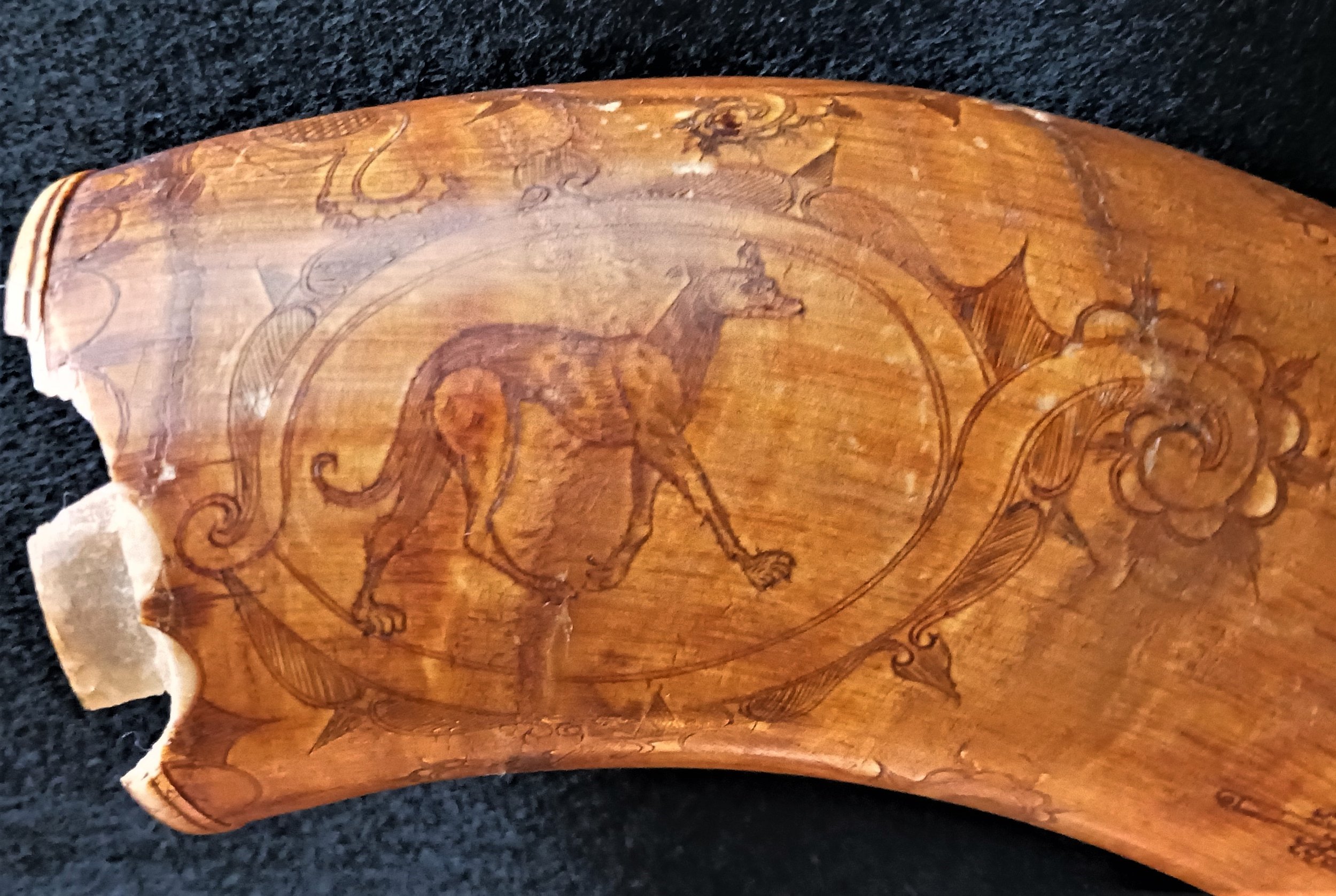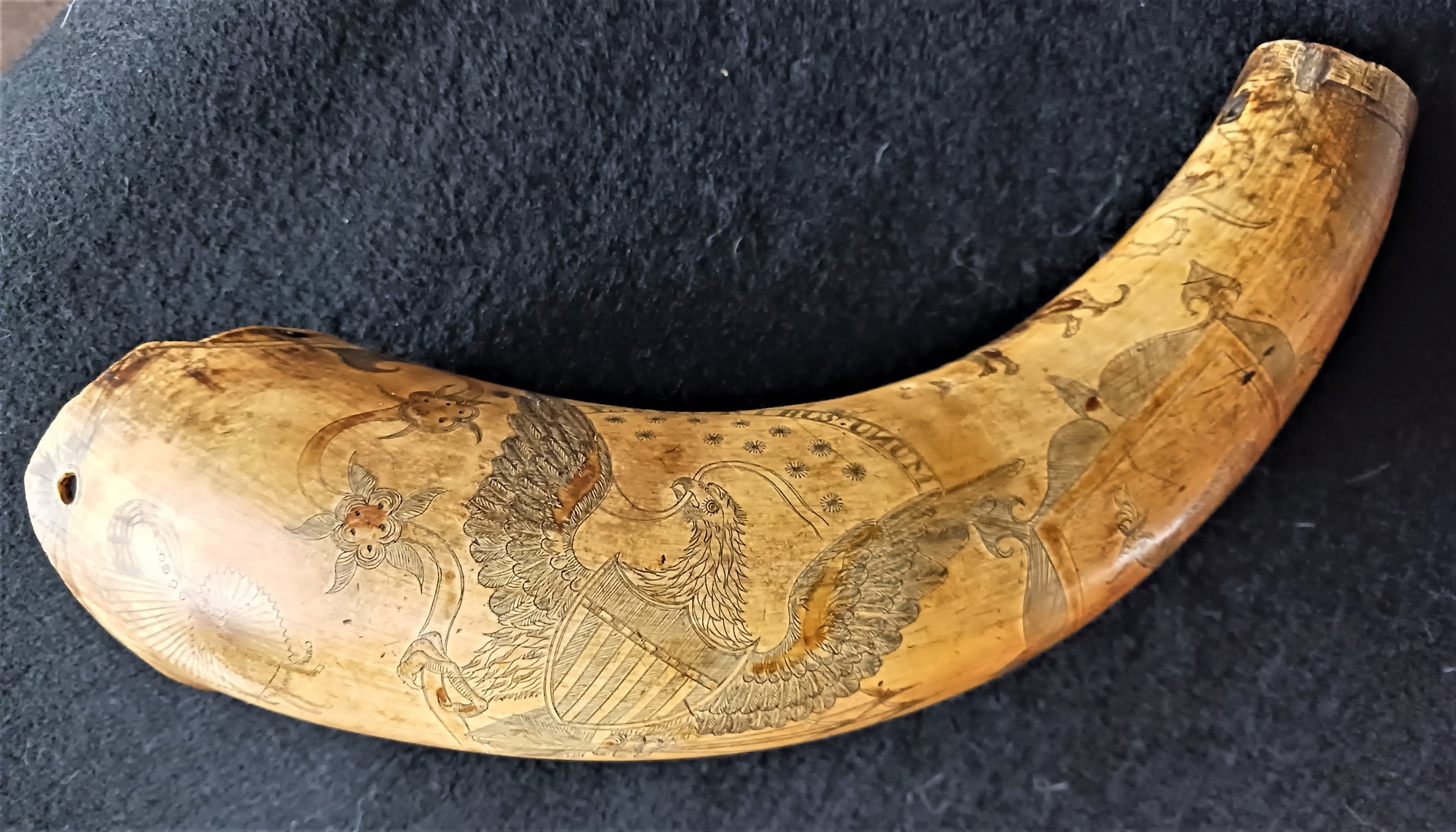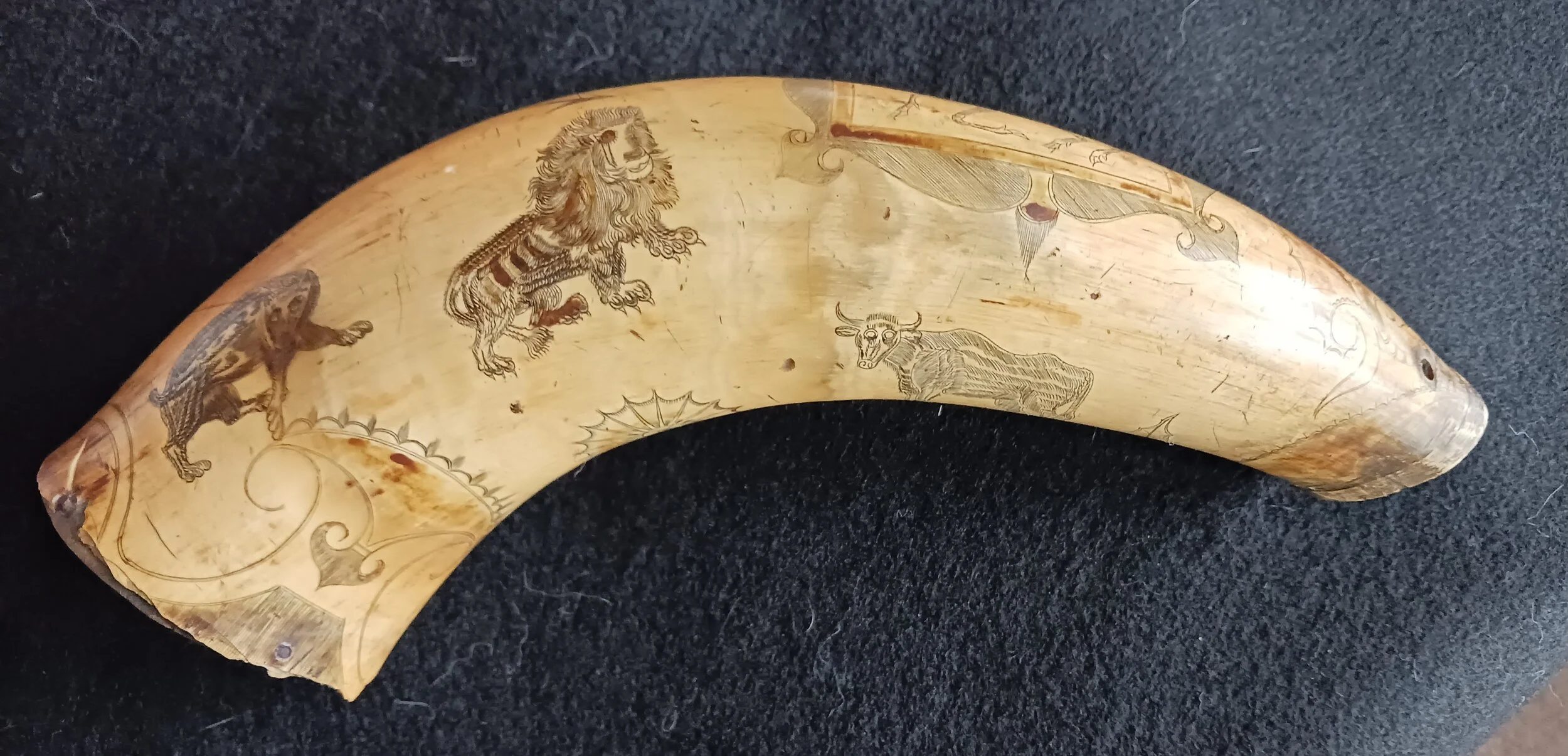The Ultimate Tansel Artistry, “Big Knuckle Eagle” Powder Horns ©
Overview: A small group of Tansel powder horns made in Kentucky about 1820 are known as the “big knuckle eagle” horns. They achieved the highest level of artistry known among Tansel horns. The horns are identified by their superbly carved eagles with “big knuckles” on their talons. Known horns are not signed or dated, but comparative analysis of their artwork has identified the carvers as Francis Tansel and his oldest son John Tansel. These horns represent an important step in Tansel horn evolution, with the eagle changing from its earlier “droopy wing” form to the later, more robust “raised wing” form. Some “big knuckle eagle” horns share another rare detail. Two of the known horns, one by Francis and one by John, originally had basal lobes for strap attachment, an antiquated detail not seen on any earlier or later Tansel powder horns. The lobed horns had flat, in-set horn butt plugs.
Big Knuckle Eagles: The term “big knuckle eagle” is easily explained. The legs and feet on the eagles are unique among Tansel eagles, being exceptionally stocky and powerful in appearance. The eagle’s right foot [viewer’s left] is always turned sideways in profile, while the left foot [viewer’s right] faces directly forward with three large talon sections visible. Those three talon sections have large, round knuckles not seen on other Tansel eagles… thus the name “big knuckle eagles.”
The eagles themselves are large, robust, and exhibit exceptional workmanship, making them the Tansels’ most beautifully carved eagles. Several details on the eagles are noteworthy. The top edge of each wing is not smooth, but instead has three softly defined, individual feathers giving the wing a more elegant appearance. The detail survived into the next phase of Tansel horn carving but then disappeared as wings reverted to the easier-to-carve smooth edged wings. In addition, individual wing feathers are clearly defined and intensely veined, creating more realistic feathers. Wings were evolving in another way, moving closer to the later “standard” wing design with three rows of feathers. Legs on “big knuckle eagles” are also noteworthy for being short and wide with no visible knee joint; most later legs were thinner with a defined knee joint between the large thigh and smaller lower leg section.
Figure No.1-a: The “big knuckle eagle” on this Francis Tansel powder horn is beautifully carved with its feathery, up-lifted wings and robust legs and feet. Note the talons on the left foot [viewer’s right] with the large knuckles, a trademark of these horns. Francis left his knuckles mostly white with the space in between the knuckles shaded dark as on this horn. Author’s collection.
Dating: “Big knuckle eagle” horns can be dated by their position in the artistic progression of Tansel horns. The earlier and smaller “droopy wing” eagle was used from before the War of 1812 until 1819. Two signed John Tansel horns dated “April 1819” have “droopy wing” eagles along with several non-standard figures, i.e., a nautilus and giraffe, that appear on two of the “big knuckle eagle” horns. Further, the “dog head” spout phase of Tansel horns dates to about 1816-1819, and one of the “big knuckle eagle” horns has an animal-head spout resembling a bird’s head. The presence of the nautilus, giraffe, and animal-head spout, along with the first appearance of a “raised wing” eagle, strongly suggests the “big knuckle eagle” horns were carved soon after 1819. On the other side of the dating progression, two Francis Tansel horns are known with his “F*T” initials and an “1821” date, along with a John Tansel horn with “J T” initials and an “1821” date; all have a later, more conventional style of “raised wing” eagle with smaller feet, indicating the “big knuckle eagle” phase was gone by/before 1821. The time period for the “big knuckle eagle” horns is therefore established as 1819-1820. The small number of surviving horns indicates it was a brief [but important] phase probably lasting less than a year.
Carver Identity: The left foot on “big knuckle eagles” allows the work of Francis Tansel to be differentiated from the work of his son John. While both carvers made the left [viewers’ right] foot about the same size and shape, their shading techniques differed. Francis used large, round, mostly white knuckles at either end of each talon section, separated by a center portion that was shaded dark. Conversely, John shaded his large, round talon knuckles dark and left a white section in between. There are other details in the carved figures that help identify the carver’s hand, but the “big knuckle” shading technique is the easiest way to identify the carver of a “big knuckle eagle” horn. The author has documented four “big knuckle eagle” Tansel horns [hopefully more exist], two carved by Francis Tansel and two by his son John. An example of each carver’s work is illustrated below. Despite significant damage to both horns, they represent a brief but important phase of Tansel horn work that displays the highest level of Tansel artistry when compared to other Tansel horns.
Francis Tansel’s Horn: The horn in Figures No.1 is known as the “Washington Horn” and is arguably the finest work extant by Francis Tansel despite significant damage. When new, it had a large lobe for basal strap attachment and a flat horn plug. A partial provenance states the horn was found in California many years ago, was less damaged when found, and had silver decoration. Despite a darkened surface, all carving is visible and superbly executed.
Figure No.1-b: The front of Francis Tansel’s “big knuckle eagle” powder horn has darkened with age but shows its finely carved eagle, namesake image of George Washington, and a running deer left of the eagle. The spout has been shortened and damaged, but the horn’s body and carving remain intact. Author’s collection.
Figure No.1-c: The reverse of Francis Tansel’s “bug knuckle eagle” horn shows his fine border carving around the throat’s “fish-mouth” where the spout emerges, an early dog without a collar, and a fasces [symbol of authority] under the George Washington image. Author’s collection.
Figure No.1-d: Near the base of the Francis Tansel horn are two deer carved in his typical repose style. The graceful curve of the antlers indicates the carving was done by Francis Tansel. Above the deer, a small remnant of the original basal lobe for strap attachment is seen protruding above the thin relief-carved band that encircles the base of the horn. Author’s collection.
Figure No.1e: A well-proportioned dog without a collar decorates the basal area of the Francis Tansel powder horn. Both the dog and cartouche borders are typical of Francis’ work. When John Tansel carved dogs on his horns, he usually put collars on them. Author’s collection.
Figure No.1-f: An “E Pluribus Unum” banner arches over the eagle’s head and just above it is a large sunburst figure. The sunburst helps identify Francis Tansel’s horns from those of his son John. Francis often put a face inside his sunbursts while John did not. Author’s collection.
Figure No.1-g: The open end of the Francis Tansel horn has a white scar where the original front lobe was broken off. The slightly darker area just inside the horn shows the thickness of the horn’s original flat horn or wood butt plug. Author’s collection.
John Tansel’s Horn: The second “big knuckle eagle” horn illustrated in Figures No.2 was made by John Tansel; numerous details show his hand including the nautilus figure, deer with awkward front leg and upward pointing antlers, and his one-eyed lion. The horn is important for its: 1) remnant of a basal lobe for strap attachment, and 2) original flat horn plug. The horn originally had a spout extension, probably horn but perhaps metal, now missing. The throat’s border carving stops a quarter inch from the cutoff end of the horn, showing where the missing spout extension once overlapped the horn body and forced the carving to stop. This John Tansel horn and the Francis Tansel horn above, when viewed together, demonstrate the superior artistry of the “big knuckle eagle” powder horns when compared to most other Tansel horns.
Figure No.2-a: The front of John Tansel’s “big knuckle eagle” powder horn shows his finely carved eagle with up-lifted wings and highly detailed feathers. Also visible is a nautilus shell carving to the left of the eagle that was only used by John Tansel. To its left is the remnant of the original basal lobe with hole for strap attachment, a rare detail found on two of the known “big knuckle eagle” horns. Author’s collection.
Figure No.2-b: The reverse of the John Tansel horn has his “trademark” one-eyed lion that appears on other horns he made. Also present is his short-tailed bear to the left of the lion, and a shorthorn cow reminiscent of the fine shorthorn cattle bred in central Kentucky that provided the creamy colored, perfectly sized horns used by the Tansels. The small hole near the spout end held some kind of eyebolt for rear strap attachment. A bit of the flat horn butt plug’s edge is visible and shows how thick it was. Author’s collection.
Figure No.2-c: A close-up of the John Tansel eagle shows the large knuckles on the left [viewer’s right] foot with darker outer knuckle area and lighter area in between. This shading is opposite of the shading used by Francis Tansel and allows “big knuckle eagle” horns to be properly attributed. Author’s collection.
Figure No.2-e: Two important details on John Tansel’s “big knuckle eagle” horn are its original flat horn butt plug [now warped], and a large remnant of the original basal lobe with hole for strap attachment. The thick horn butt plug’s edge is partially visible in this view, as are the nails used to hold it in place. Note the starburst figure in the lower right; it was reproduced on the top surface of the attachment lobe. Author’s collection.
Figure No.2-d: A running deer inside a rectangular cartouche highlights several details used by John Tansel: 1) a slightly awkward front leg on the deer, 2) antlers that point almost straight upward, 3) large, thick body, and 4) a shorter, less pointed head. Author’s collection.
Figure No.2-f: The basal lobe remnant has a decorative “starburst” pattern, implying the original lobe was semi-circular in shape. Also visible is a small section of the original fine chip-carving that ran around the horn’s basal edge and outer edge of the lobe. The Tansels placed their strap attachment lobes on the front side of the horn, not on the top as on earlier Eastern horns. Author’s collection.













